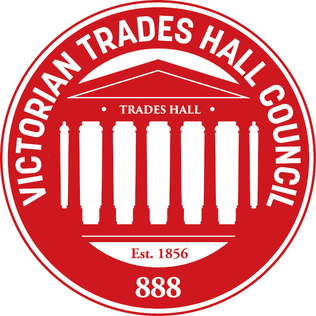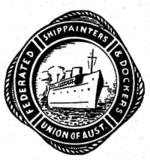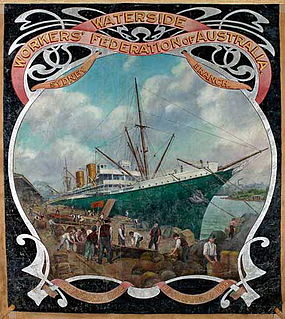
The Australian Council of Trade Unions (ACTU), originally the Australasian Council of Trade Unions, is the largest peak body representing workers in Australia. It is a national trade union centre of 46 affiliated unions and eight trades and labour councils. The ACTU is a member of the International Trade Union Confederation.
Trade unions in Malaysia are regulated by the Trade Unions Act of 1959.
The Australian labour movement began in the early 19th century and since the late 19th century has included industrial and political wings. Trade unions in Australia may be organised on the basis of craft unionism, general unionism, or industrial unionism. Almost all unions in Australia are affiliated with the Australian Council of Trade Unions (ACTU), many of which have undergone a significant process of amalgamations, especially in the late 1980s and early 1990s. The leadership and membership of unions hold and have at other times held a wide range of political views, including communist, socialist and right-wing views.

The Australian Workers' Union (AWU) is one of Australia's largest and oldest trade unions. It traces its origins to unions founded in the pastoral and mining industries in the 1880s and currently has approximately 80,000 members. It has exercised an outsized influence on the Australian trade union movement and on the Australian Labor Party throughout its history.

The Victorian Trades Hall Council (VTHC) is a representative body of trade union organisations, known as a labour council, in the state of Victoria, Australia. It comprises 43 affiliated trade unions and professional associations, and eight regional Trades and Labour Councils of Victoria.
The 1890 Australian maritime dispute was an industrial dispute that began on 15 August 1890 when the Mercantile Marine Officers' Association directed its members to give 24 hours' notice to their employers after negotiations broke down with the Steamship Owners' Association of Victoria over longstanding pay and conditions claims. Industrial action quickly spread to seamen, wharf labourers, then gas stockers. Coal miners from Newcastle, Broken Hill, and even New Zealand were locked out after refusing to dig coal for non-union operated vessels. By September 1890, 28,500 workers were on strike.

The Queensland Council of Unions (QCU) is a representative, an advocacy group, or peak body, of Queensland trade union organisations, also known as a labour council, in the Queensland, Australia. As of 2020, 26 unions and 13 regional branches were affiliated with the QCU. The QCU represents unions covering around 350,000 Queensland workers. It is affiliated with the Australian Council of Trade Unions (ACTU). Its offices are located in the suburb of South Brisbane, Queensland. As a peak body for the Queensland trade unions, the objective of the QCU is to achieve industrial, social and political justice for Queensland workers. The management structure of the QCU is made up of a committee of management and an executive of representatives comprised from affiliated unions.

The Maritime Union of Australia (MUA) was a union which covered waterside workers, seafarers, port workers, professional divers, and office workers associated with Australian ports. The MUA was formed in 1993 with merger of the Seamen's Union of Australia and the Waterside Workers' Federation of Australia.

The Federated Ship Painters and Dockers Union (FSPDU) was an Australian trade union which existed between 1900 and 1993. It represented labourers in the shipbuilding industry, covering "mostly work associated with chipping, painting, scrubbing [and] cleaning [ships], working in every size of tanks, cleaning boilers, docking and undocking vessels, and rigging work".
The Liverpool Dockers' dispute was a lengthy dispute between dockers, their employers Mersey Docks and Harbour Company (MDHC) and Torside Ltd, which lasted for twenty-eight months between 1995 and 1998 in Liverpool, England. Although considered a strike, it was strictly a lockout as the employers, Mersey Docks, sacked the dockers for breach of contract when they refused to cross a picket line set up by their sacked Torside Limited colleagues. Initially, five Torside workers were dismissed following a dispute regarding overtime pay, who in turn formed a picket line that other dockers refused to cross in solidarity.
The Mudginberri abattoir was the focus of a major industrial relations dispute from 1983 to 1985 in Australia's Northern Territory which was notable for being the first successful use of legal sanctions against a union since the gaoling of Victorian Tramways union leader Clarrie O'Shea in 1969. The successful prosecution of the Australasian Meat Industry Employees Union (AMIEU) under section 45D of the Trade Practices Act was seen by the National Farmers Federation and the developing New Right in and outside the Liberal Party of Australia as a breakthrough in a campaign to break the power of the unions and introduce contract employment.

The Sheffield Trades and Labour Council, usually known as the Sheffield Trades Council, is a labour organisation uniting trade unionists in Sheffield.

The Great Strike refers to a near general strike that took place in New Zealand from October 1913 to mid-January 1914. It was the largest and most disruptive strike in New Zealand's history. At its height, it brought the economy of New Zealand almost to a halt. Between 14,000 and 16,000 workers went on strike, out of a population of just over one million.
The Dollar Sweets dispute in 1985 was a small industrial dispute with major legal ramifications in industrial relations where an employer resorted to a common law verdict and damages in a case in the Supreme Court of Victoria to resolve a dispute after industrial courts proved ineffective. It was the first time a trade union was forced to pay common law damages to an employer for losses suffered through picketing in Australia. The dispute was also significant for boosting the career of the barrister representing the company, Peter Costello, leading him to stand for federal Parliament and become Treasurer in the Howard Government.
The Permanent & Casual Wharf Labourers Union of Australia (PCWLU) was an Australian union for maritime labourers.

The Labor Council of New South Wales, branded Unions NSW, is the peak body for trade unions in the state of New South Wales, Australia. As of 2005 there are 67 unions and 8 Rural and Regional Trades & Labor Councils affiliated to the Labor Council, representing 800,000 workers in NSW. It is registered as the State Peak Council of Employees under Section 215 of the Industrial Relations Act 1996 (NSW). The council is affiliated with the Australian Council of Trade Unions (ACTU).
The service model generally describes an approach whereby labour unions aim to satisfy members' demands for resolving grievances and securing benefits through methods other than direct grassroots-oriented pressure on employers. It is often contrasted to the organising model, and to rank and file organization.
The Federated Moulders' (Metals) Union of Australia (FMMUA) was an Australian trade union which existed between 1899 and 1983. It represented moulders – skilled tradesmen who fabricated the moulds for casting metal products in foundries. In spite of only organising within a single skilled occupation, which kept total membership low, the vital position of moulders in major industries such as mining, manufacturing and the railways, ensured that the union remained industrially powerful with a reputation for being highly militant.

The Waterside Workers' Federation of Australia (WWF) was an Australian trade union that existed from 1902 to 1993. After a period of negotiations between other Australian maritime unions, it was federated in 1902 and first federally registered in 1907; its first general president was Billy Hughes.
The Food Preservers' Union of Australia (FPUA) was an Australian trade union which existed between 1898 and 1992. It represented a broad range of production workers in the food processing industry, including many female members.










